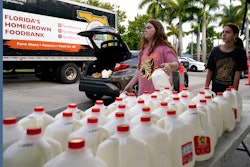
People who work in food manufacturing environments spend a lot of time walking and standing to conduct their work. Due to the wet nature of food processing, they are 25% more likely to experience a slip or fall at work than workers in other manufacturing sectors. The repercussions of these accidents can be costly and time-consuming.
According to the National Safety Council, in 2019 through 2020, companies spent around $48,000 per falls or slips on workers’ compensation costs. When accidents result in claims an unannounced visit from the Occupational Safety and Health Administration (OHSA) can follow.
OSHA expects companies to conduct regular safety inspections on their own accord and by qualified people. According to the agency, a qualified person is someone knowledgeable about the manufacturers’ specifications and recommendations, trained to make inspections and identify both existing and potential hazards.
Surface Safety Audits: How to Do Them
A Walking Surface Safety Assessment is a facility review specifically designed to identify potential trip and fall hazards. Traffic, environment, and walking surface are the most important surface safety factors an auditor or safety team should consider, and each has several components. It’s also important to listen to employees and revisit any injury events to determine causes.
To conduct a surface safety assessment, get out on the floor. Workers in food processing often have the added challenge of water, grease, and animal fats, all of which can make walking surfaces slippery and more challenging. Walk the manufacturing line and analyze and document the findings.
Traffic—Look at traffic and consider the volume and type
- Are people moving in one direction or both?
- What is moving around: employees, carts, trucks, forklifts?
- Note any challenges, such as controlling heavy carts on slick surfaces.
Wet areas—Keep a close eye on the processing lines, areas near mixing machines, feeders, baggers and other equipment
- Watch for trench and round drains and surfaces that collect liquids. Do people have to walk across drains? If so, they should be fabricated with high-traction, anti-slip surface technologies.
- Pay particular attention to freezer and cold storage areas. Condensation and moisture create significant slip hazards.
- What contaminants accumulate on floors, such as water, oil, or animal fats, and how are they being cleaned? Some cleaning solutions break down a surface’s anti-slip properties. Select a detergent that upholds food processing sanitation requirements without degrading the flooring.
Slippery surfaces—Talk to employees during the safety assessment. More importantly, listen and observe
- Are there surfaces people continually slip on? Employees know where the problems are and often share that information with each other.
- “Slippery When Wet” signs often highlight a deeper safety issue that can be mitigated with a better solution.
- Caution tape flags a dangerous area, drawing attention to a problem management hasn’t resolved. Temporary grip tape wears fast and can very quickly begin to peel becoming a trip hazard.
Elevated surfaces—Platforms, catwalks, mezzanines, crossovers, stairs, and ladders are common fixtures in food manufacturing and employee depend on them to access mixers and other equipment. Visit each one in the facility
- Are there trip hazards on elevated areas, such as neoprene mats that can roll up or change the walking surface?
- Do stairs have high-friction treatments on the nosing and the hand railings?
Performing routine audits shows employees safety is a priority and can help prevent accidents that lead to OSHA inspections. If there isn’t a person on staff who is considered qualified, third-party experts are available to conduct thorough audits and suggest mitigation solutions. SLIPNOT has Walking-Working Surfaces and Fall Protection Specialists who are trained and certified by the National Association of Safety Professionals (NASP). They can:
- Conduct walking surface safety assessments
- Test the traction levels of existing walking surfaces identifying high risk areas
- Identify surfaces that can be easily and quickly retrofitted to decrease slip and fall risks
- Compare the total cost of ownership of different surfaces and support the business case for mitigation costs
---
William Davidson is the CEO and President of SLIPNOT, a leading provider of specialized safety flooring products and surface technologies.























